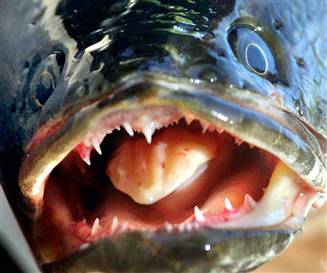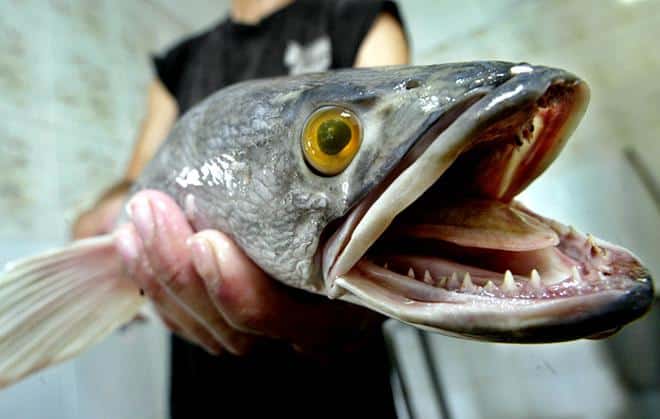They sound like creatures spawned in a low-budget horror movie: eel-like fish with sharp teeth, the ability to breathe air and move on land, and known for their unpleasantly aggressive tendencies. But the snakehead fish (Channa sp.) are neither Hollywood nightmare nor urban legend – they’re real, and their numbers are growing in the U.S.

Snakeheads are freshwater fish from Asia, first imported to the United States for food and as aquarium fish. There are several species currently known to be reproducing in our waters, with the Northern Snakehead being most prevalent. Snakeheads can reach 3-4 feet in length and do have sharp teeth and strong jaws.
According to the U.S. Fish and Wildlife Service, snakeheads can survive in water with very low oxygen levels and are capable of breathing atmospheric oxygen, with some species able to make short overland migrations in moist, swampy conditions. They do not attack humans, however, and cannot survive for more than a few hours on dry land. There are no known reproducing snakehead populations in Georgia at this time, but Northern Snakeheads are thriving as nearby as North Carolina and Florida and there are growing concentrations across the Mid-Atlantic region.
As with all exotic invasive species, the primary concern about snakehead fish is their impact on native species and the local ecosystem. Snakeheads prey on native fish as well as competing with them for food and habitat. Wildlife managers in some states with known snakehead fish populations have attempted a variety of control methods to eradicate them, but the consensus is that they’re here to stay.


We can all do our part to help prevent the introduction and spread of non-native fish species. Never release any fish or animals into a body of water unless they came from that water, and clean and dry your boat and fishing equipment before moving it from one body of water to another.
So what should you do if you catch one?
- Never release the fish back into the water
- Either place it on ice, freeze it, or kill it in a humane way
- Take a photo of the fish for proper identification
- Contact the U.S. Fish and Wildlife Service
Additional Resources:


